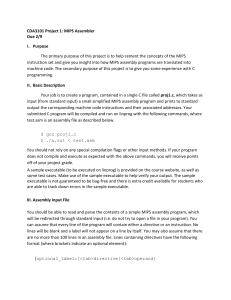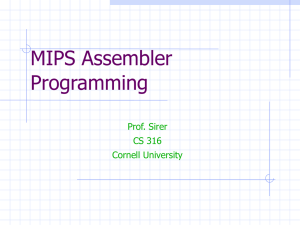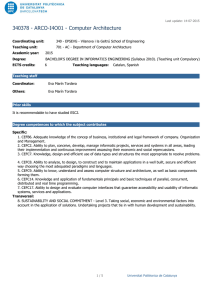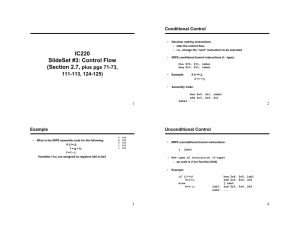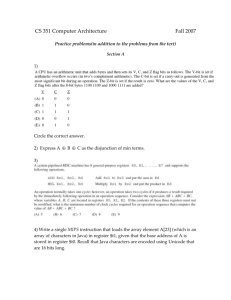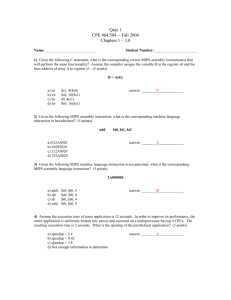CDA3101 Project 1: MIPS Assembler Due 6/5 I. Purpose
advertisement
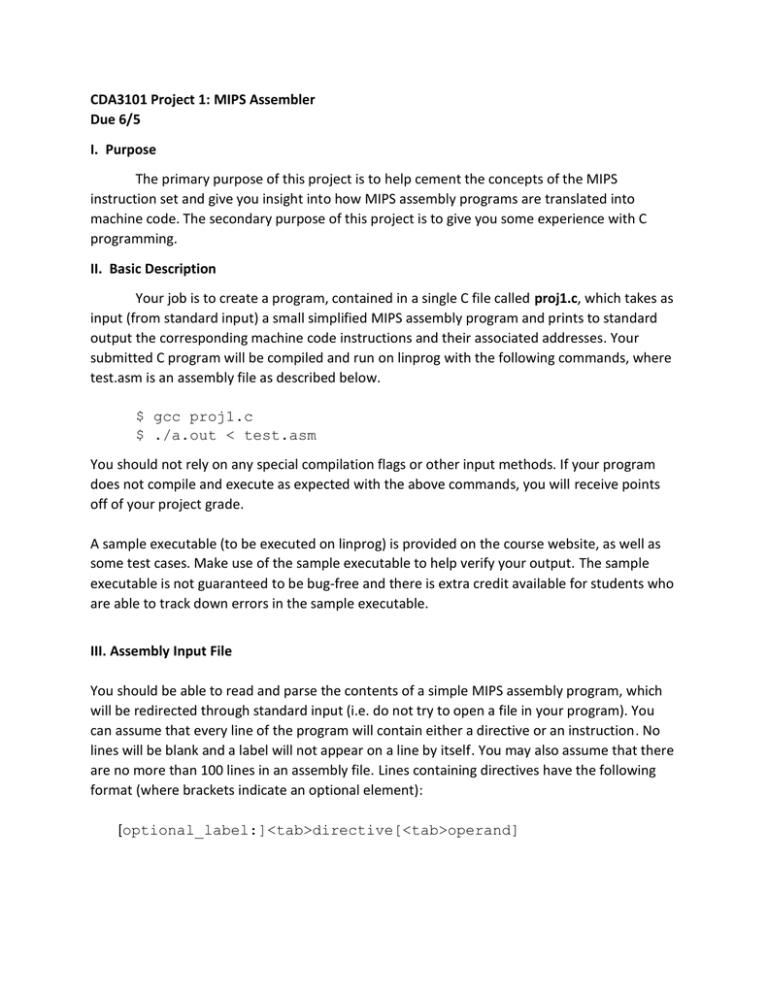
CDA3101 Project 1: MIPS Assembler Due 6/5 I. Purpose The primary purpose of this project is to help cement the concepts of the MIPS instruction set and give you insight into how MIPS assembly programs are translated into machine code. The secondary purpose of this project is to give you some experience with C programming. II. Basic Description Your job is to create a program, contained in a single C file called proj1.c, which takes as input (from standard input) a small simplified MIPS assembly program and prints to standard output the corresponding machine code instructions and their associated addresses. Your submitted C program will be compiled and run on linprog with the following commands, where test.asm is an assembly file as described below. $ gcc proj1.c $ ./a.out < test.asm You should not rely on any special compilation flags or other input methods. If your program does not compile and execute as expected with the above commands, you will receive points off of your project grade. A sample executable (to be executed on linprog) is provided on the course website, as well as some test cases. Make use of the sample executable to help verify your output. The sample executable is not guaranteed to be bug-free and there is extra credit available for students who are able to track down errors in the sample executable. III. Assembly Input File You should be able to read and parse the contents of a simple MIPS assembly program, which will be redirected through standard input (i.e. do not try to open a file in your program). You can assume that every line of the program will contain either a directive or an instruction. No lines will be blank and a label will not appear on a line by itself. You may also assume that there are no more than 100 lines in an assembly file. Lines containing directives have the following format (where brackets indicate an optional element): [optional_label:]<tab>directive[<tab>operand] Lines containing instructions have the following format: [optional_label:]<tab>instruction<tab>operands Operands are always comma-separated with no whitespace appearing between operands. The supported directives are listed in the following table. You may assume that the entire .text segment always precedes the .data segment. You may also assume that the memory allocation directives only ever have a single operand. Directive .data .text .space n .word w Meaning Indicates the start of the data section. Indicates the start of the text section. Allocate n bytes of memory. Allocate a word in memory and initialize with w. The supported instructions include the following. You may wish to consult an additional MIPS reference page for more specific information about the instructions and their machine code formats. Instruction ADD ADDI NOR ORI SLL LUI SW LW BNE J LA Type R I R I R I I I I J - Opcode/Funct (decimal) 32 8 39 13 0 15 43 35 5 2 - Syntax add $rd,$rs,$rt addi $rt,$rs,immed nor $rd,$rs,$rt ori $rt, $rs, immed sll $rd, $rt, shamt lui $rt, immed sw $rt,immed($rs) lw $rt,immed($rs) bne $rs,$rt,label j label la $rx,label The registers to be recognized include the following. Registers $t0-$t7 $s0-$s7 $0 Decimal Representation 8-15 16-23 0 Registers will always be expressed as $[letter][number] or $0. Note the use of labels in the branch and jump instructions. You will need to calculate the appropriate immediate and targaddr fields for the machine code based on the layout of your assembly file. The immediate field of a branch instruction will be defined using PC-relative addressing where the address of the destination is defined as Addr(dest) = Addr(branch) + immed*4 That is, the immediate field represents the distance, in instructions rather than bytes, between the branching instruction and the destination instruction. The targaddr field of the jump instruction will be defined using pseudo-direct addressing where the address of the destination is defined as Addr(dest) = Addr(jump)[31-28] || targaddr || 00 Where Addr(jump)[31-28] is the 4 most significant bits of the jump instruction, and || denotes concatenation. Also note the use of the load address instruction. The load address instruction is a MIPS pseudoinstruction which is supported by many MIPS assemblers, but does not directly correspond to a MIPS instruction. Our assembler must replace any use of the load address instruction with a lui instruction, followed by an ori instruction. For example, _a: la $t0,_a .space 100 should be translated to _a: lui $t0,_a[31-16] ori $t0,$t0,_a[15-0] .space 100 Where _a[31-16] is the upper 16 bits of the address corresponding to label _a, and _a[15-0] is the lower 16 bits of the address corresponding to label _a. Although this is not realistic, for consistency, we will zero-out all fields which are not welldefined for an instruction. These include the rs field for lui and sll as well as shamt for most Rtype instructions. IV. Suggested Development Approach Your assembler, just like a real assembler, will need to make two passes over the assembly file. During the first pass, the assembler should associate each symbolic label with an address. You may assume that the first instruction starts at address 0. You may also assume that memory allocations occur directly after the instructions in the process space. During the second pass, you should translate the symbolic assembly instructions into their corresponding machine code. You should print the address, followed by a space, and then the instruction. Both the address and the instruction should be in hexadecimal format and every instruction should appear on its own line. You may find the functions fgets and sscanf to be particularly useful for this assignment. The fgets function has the following prototype: char *fgets(char *str, int n, FILE *stream); The fgets function reads n characters from stream and writes them to the str buffer. On success, the function returns the same str parameter. If the end-of-file is encountered, a null pointer is returned. The sscanf function has the following prototype: int sscanf(const char *str, const char *format, ...); The sscanf function scans the str buffer to try to match the format specifiers in the format string. Additional pointer arguments may be supplied to indicate variables that should be filled with elements found in the str buffer. You may need to consult some documentation to use these functions properly. Do not ask me what the format strings should look like – this is part of the assignment! You must be able to read the documentation on these functions and figure out how to use them if you choose to do so. You may also want to make use of the bitwise left and right shift operators (<< and >>) to manage the instruction fields easily. There is no need to “translate” decimal values of the instruction fields into binary manually – they are already represented as binary numbers in memory! Also, watch out for signed-ness. Lastly, no error checking is required. You may assume that the assembly input will be correctly formed. V. Sample Output A sample executable is provided, but here is quick run-through. Let’s assume the test case test2.asm contains the following: .text main: la lw addi sw .data _a: .space $s0,_a $t6,0($s0) $t7,$t6,1 $t7,0($s0) 4 Then running the sample executable with test2.asm as input yields the following output. > ./proj1_linprog < tests/test2.asm 0x000000: 0x3C100000 0x000004: 0x36100014 0x000008: 0x8E0E0000 0x00000C: 0x21CF0001 0x000010: 0xAD0F0000 VI. Miscellaneous Submissions may be made through Blackboard in the Assignments section. You must submit before 11:59 PM on June 1 to receive full credit. Late submissions will be accepted for 10% off each day they are late, for up to two days. The first person to report any errors in the provided materials will be given 5% extra credit. Automatic plagiarism detection software will be used on all submissions – any cases detected will result in a grade of 0 for those involved.
